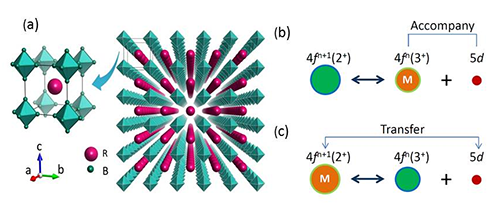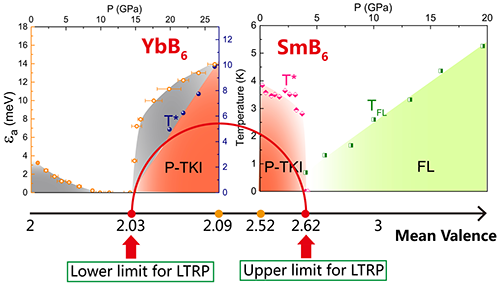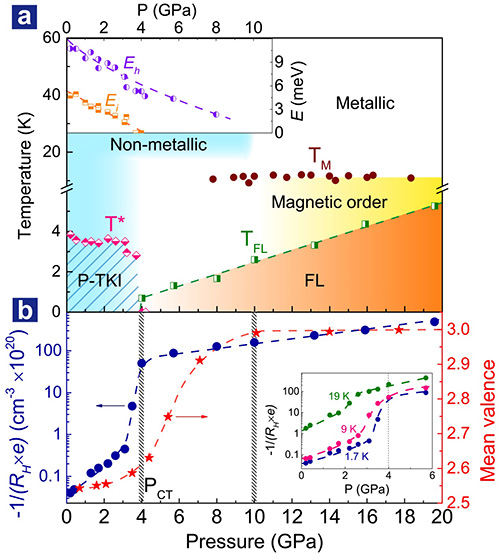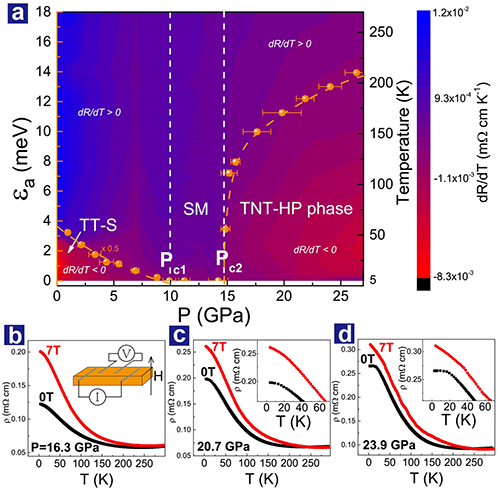中国科学院物理研究所
北京凝聚态物理国家研究中心
SC4组供稿
第50期
2017年11月10日
具有奇异特性的近藤稀土硼化物SmB6研究进展
SmB6 是上世纪60年代就开始研究的经典近藤(Kondo)稀土硼化合物,其令人困惑的低温电阻平台一直是强关联物理领域研究的一个重要问题。近年随着奇异的低温量子振荡和与体绝缘态共存的金属表面态在SmB6中的发现,使其重新成为研究热点。最近,中国科学院物理研究所/北京凝聚态物理国家实验室(筹)超导实验室孙力玲研究员与合作者提出了SmB6在低温下呈现出的一系列奇异性的低温现象均源自其Sm离子中f电子独特的构型与其所处的具有“负膨胀”特性的B6框架结构在不同温度下相互作用导致的特殊的价态变化, 使其基态处于一种不稳定的“伴随型”价态涨落,即由f电子构型所决定的磁性Sm离子数量与传导电子的数量在涨落中同时增加或减少,这与常见的其它磁性离子价态变化中的情况完全不同。在稀土六硼化物中,只有SmB6和YbB6具有这种特殊的价态涨落形式。这一新观点以“Puzzle maker in SmB6: accompany type of valence fluctuation state”为题作为Key issue review文章发表在Reports on Progress in Physics (RoPP 80,112501, 2017)上。
上述观点的提出是基于近年来她和博士生周亚洲(与赵忠贤院士联合培养)与物理所杨义峰研究员、 孙培杰研究员等以及人民大学俞榕教授和美国Rice大学斯其苗教授合作,对加州大学Z. Fisk教授组提供的高质量SmB6和YbB6单晶样品进行的一系列高压下电阻、磁阻、Hall测量以及高压同步辐射XRD和吸收等多种原位手段的协同研究所取得的实验结果和深入分析。在对SmB6的极低温高压研究中发现,在4 GPa的压力下SmB6发生了由常压奇异量子态到具有重费米子行为的量子态转变,澄清了SmB6在4 GPa压力下其基态是非费米液体还是费米液体的长期争论。此外,还揭示了SmB6 中奇异拓扑表面态消失的临压力与价态变化的内在关联性,并给出了高压相图中不同的电子态与价态、Hall系数及能隙随压力演化的对应关系。在对SmB6的姊妹化合物YbB6研究中,发现了压力诱导的常压半导体相→半金属相→绝缘相的量子相变,并在15 GPa的压力下观察到了与SmB6类似的低温电阻平台和X射线吸收谱中的Yb离子由2价到3价谱权重的转移,说明高于该压力下YbB6出现了混合价的特征。由此提出了新的绝缘相可能起源于Yb的d-f杂化,并且很可能是一个类似于SmB6的拓扑近藤绝缘相。这些结果以Quantum phase transition and destruction of Kondo effect in pressurized SmB6,Pressure-induced quantum phase transitions in a YbB6 single crystal和Pressure-induced exotic states in rare earth hexaborides为题目分别发表在【Sci. Bulletin -2017,PRB(R)& Editor suggestion -2015和RoPP -2016】上。
该系列研究得到了科技部(No.2016YFA0300300, No. 2017YFA0302900),基金委(No.91321207, No.11427805, No. U1532267)和中科院B类先导项目(XDB07020300)的资助。在上海光源和北京高能所同步辐射高压站完成了高压XRD和吸收实验。
相关工作链接:
http://iopscience.iop.org/article/10.1088/1361-6633/aa7e3a/pdf
http://iopscience.iop.org/article/10.1088/0034-4885/79/8/084503/pdf
https://journals.aps.org/prb/pdf/10.1103/PhysRevB.92.241118
https://doi.org/10.1016/j.scib.2017.10.008
上述观点的提出是基于近年来她和博士生周亚洲(与赵忠贤院士联合培养)与物理所杨义峰研究员、 孙培杰研究员等以及人民大学俞榕教授和美国Rice大学斯其苗教授合作,对加州大学Z. Fisk教授组提供的高质量SmB6和YbB6单晶样品进行的一系列高压下电阻、磁阻、Hall测量以及高压同步辐射XRD和吸收等多种原位手段的协同研究所取得的实验结果和深入分析。在对SmB6的极低温高压研究中发现,在4 GPa的压力下SmB6发生了由常压奇异量子态到具有重费米子行为的量子态转变,澄清了SmB6在4 GPa压力下其基态是非费米液体还是费米液体的长期争论。此外,还揭示了SmB6 中奇异拓扑表面态消失的临压力与价态变化的内在关联性,并给出了高压相图中不同的电子态与价态、Hall系数及能隙随压力演化的对应关系。在对SmB6的姊妹化合物YbB6研究中,发现了压力诱导的常压半导体相→半金属相→绝缘相的量子相变,并在15 GPa的压力下观察到了与SmB6类似的低温电阻平台和X射线吸收谱中的Yb离子由2价到3价谱权重的转移,说明高于该压力下YbB6出现了混合价的特征。由此提出了新的绝缘相可能起源于Yb的d-f杂化,并且很可能是一个类似于SmB6的拓扑近藤绝缘相。这些结果以Quantum phase transition and destruction of Kondo effect in pressurized SmB6,Pressure-induced quantum phase transitions in a YbB6 single crystal和Pressure-induced exotic states in rare earth hexaborides为题目分别发表在【Sci. Bulletin -2017,PRB(R)& Editor suggestion -2015和RoPP -2016】上。
该系列研究得到了科技部(No.2016YFA0300300, No. 2017YFA0302900),基金委(No.91321207, No.11427805, No. U1532267)和中科院B类先导项目(XDB07020300)的资助。在上海光源和北京高能所同步辐射高压站完成了高压XRD和吸收实验。
相关工作链接:
http://iopscience.iop.org/article/10.1088/1361-6633/aa7e3a/pdf
http://iopscience.iop.org/article/10.1088/0034-4885/79/8/084503/pdf
https://journals.aps.org/prb/pdf/10.1103/PhysRevB.92.241118
https://doi.org/10.1016/j.scib.2017.10.008
 |
| Figure 1 (a) Schematic crystal structure of SmB6. In crystallographic description, SmB6takes the body center cubic structure in space group Pm3m, in which rare earth ions R (dark pink) and B6octahedron (green) are arranged in a CsCl-like packing. (b)-(c) Schematic descriptions on the electron configurations between the accompany-type valence fluctuation state and the transfer-type valence fluctuation state. |
 |
| Fig. 2 Combined phase diagram of pressure dependence of onset temperatures (T*) of the resistance plateau formation in YbB6(left panel) and SmB6(right panel), together with the relation of their mean valence. P-TKI and FL stand for the putative topological Kondo insulating state and Fermi liquid state, respectively. TFLin the right panel represents Fermi liquid temperature.εαin the left panel stands for activation energy obtained by fitting to the resistance-temperature data. The red arrows indicate the lower and upper limits of the mean valence for developing the low-temperature resistance plateau in REB6(RE=Sm and Yb). |
 |
| Figure 3 Summary of pressure dependence of temperature, inverse Hall coefficient and mean valence of SmB6. (a) Phase diagram depicted by the pressure dependence of the onset temperature of the resistance plateau (T*) and Fermi liquid (TFL), respectively. Here P-TKI and FL represent the putative topological Kondo insulating state and Fermi liquid state, respectively. TP represents the temperature of resistance peak where the sample undergoes a change from a non-metallic behavior to a metallic behavior. TMstands for the magnetic transition temperature taken from Ref. [Derr et al,Journal of Physics: Condensed Matter18, 2089]. The filled green square represents the TFLdetermined from the resistance measurements down to 0.3 K and the filled green circle represents the TFLdetermined from the resistance measurements down to 0.03 K. The inset displays pressure dependence of the two activation gapsEl(low temperature gap) andEh(high temperature gap), respectively. (b) Plots of inverse Hall coefficient (RH) and mean valance of Sm ions versus pressure. The inset displays the inverseRHas a function of pressure at different temperatures. |
 |
| Figure 4 (a) Phase diagram of pressure dependence of activation energy gap (εa, left axis) and temperature (right axis), as well as the summary ofdR/dTas a function of temperature and pressure. The orange solid dots represent the activation gap. The acronyms TT-S and TNT-HP phase stand for the topologically trivial semiconducting state and topologically non-trivial high-pressure gapped phase, respectively. SM represents semimetallic state. The value of theεain TT-S regime is scaled by 0.5 to fit the pressure dependence ofdR/dT. (b)-(d) Temperature dependence of resistance measured at zero field and 7 T at fixed pressure. The insets illustrate the details for the measurements. |

